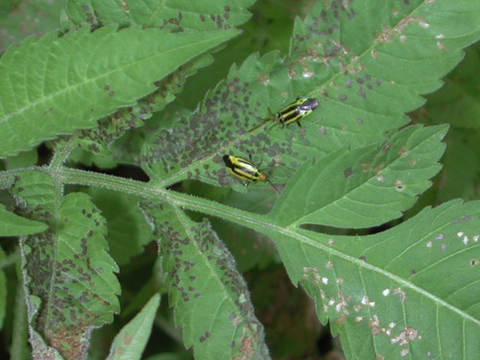Quick facts
- In most cases, fourlined plant bug feeding only affects the appearance of plants.
- Moderate to large numbers of fourlined plant bugs can be destructive to herbs.
- Ignore fourlined plant bugs when possible, especially if you have not seen much damage in recent years.
- You can use a pesticide if you wish to preserve the plants' appearance or protect edible plants.
How to identify fourlined plant bugs
Fourlined plant bug nymphs are small with developing wings.
- When they first hatch, they are bright red and have black wing pads and black dots on their abdomen.
- As the grow, nymphs are reddish orange, and the wing pads are larger with a light colored stripe on each.
Adults can be confused with beetles.
- They are greenish yellow with four black stripes running down the wings.
- The head is orange-brown and the legs are yellow-green.
- They are about ¼ - 1/3 inch long.
Both nymphs and adults have piercing-sucking mouthparts.
Biology of fourlined plant bugs
Fourlined plant bugs can feed on about 250 species of plants and are most commonly seen on:
- Herbaceous perennials - chrysanthemum, Chinese lantern, liatris and shasta daisy
- Herbs - mint and basil
- Woody ornamentals - azalea, dogwood, forsythia, viburnum, amur maple and sumac
- Flowering annuals - zinnia and marigold
- Berries - currant and gooseberry
- Vegetables – peppers
Life cycle of fourlined plant bugs
Fourlined plant bug eggs hatch in late spring as the leaves on plants start to emerge. Nymphs feed on the upper side of leaves for about four weeks, and then molt into adults.
Adults keep feeding and then mate. Females lay banana shaped eggs in two to three inch vertical slits along the plant’s stem. Adults feed until early July. There is one generation each year.
Damage caused by fourlined plant bugs
Both adults and nymphs can injure plants. They feed by inserting their needle-like mouthparts into leaves and removing chlorophyll (green pigment that helps with food production).
- This feeding produces dark, round, sunken spots, about 1/16 to 1/8 inch wide.
- The spots may become clear. After several weeks, the damaged tissue can drop out, leaving small holes.
- Severe feeding can brown leaves.
- Feeding on new growth can cause wilting.
- Fourlined plant damage may be confused with damage from leaf spot diseases.
- Fourlined plant bug damage creates spots that are similar in size and shape.
- Fungal and bacterial diseases cause spots that are of different sizes, and have discolored outer margins.
How to protect your plants
Check for bugs
Look for insects or their damage in late May and early June. The sooner they are detected, the sooner they can be managed, which helps reduce plant injury. Look carefully as bugs may drop to the ground or hide when disturbed.
Small to moderate numbers of fourlined plant bugs do not seriously harm plants. Usually, treatment is not necessary to protect the plant health.
Remove damaged plants in the fall
Cut down host plants in the fall to remove eggs that may have been inserted into them. Be sure to bury or compost removed plant material or remove plant residues from the landscape area.
Consider using pesticides
Insecticidal soap can be effective against nymphs (less so against adults). Pyrethrins can also be effective. Both products must directly contact the insects to kill them. Neither product has any residual activity so repeat treatments may be needed. Insecticidal soap and pyrethrin are generally low risk to beneficial insects.
If you find high numbers of fourlined plant bugs, there are a variety of long lasting insecticides to consider. Use them carefully as they can kill a variety of insects, including natural enemies.
Examples of contact residual insecticides are: bifenthrin, cyfluthrin, lambda-cyhalothrin, and permethrin.
CAUTION: Mention of a pesticide or use of a pesticide label is for educational purposes only. Always follow the pesticide label directions attached to the pesticide container you are using. Remember, the label is the law.
Be sure that the vegetable you wish to treat is listed on the label of the pesticide you intend to use. Also be sure to observe the number of days between pesticide application and when you can harvest your crop.
Reviewed in 2019





